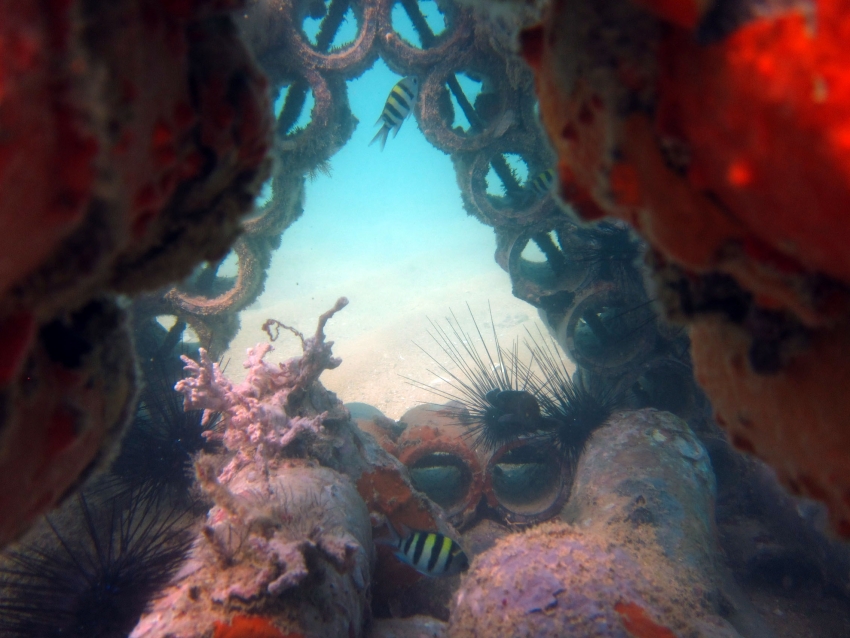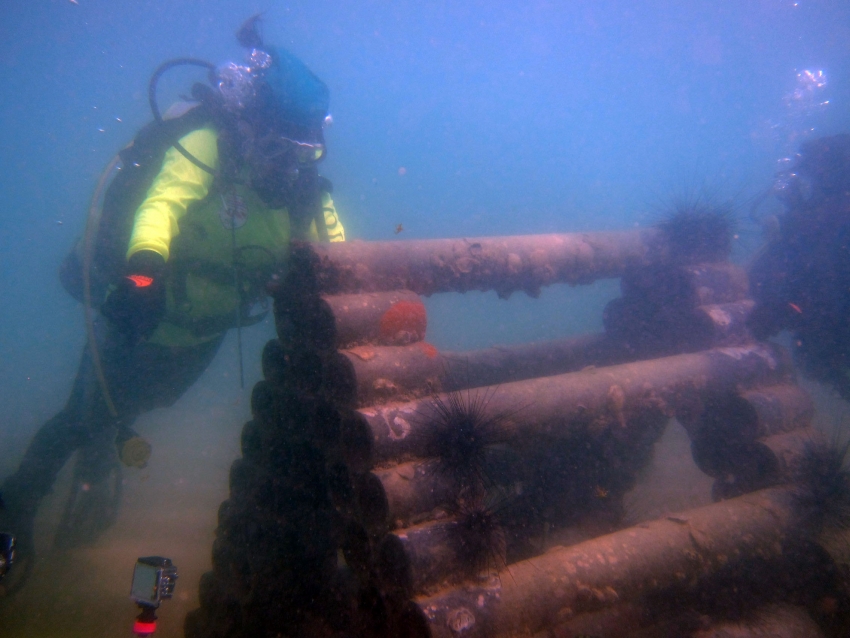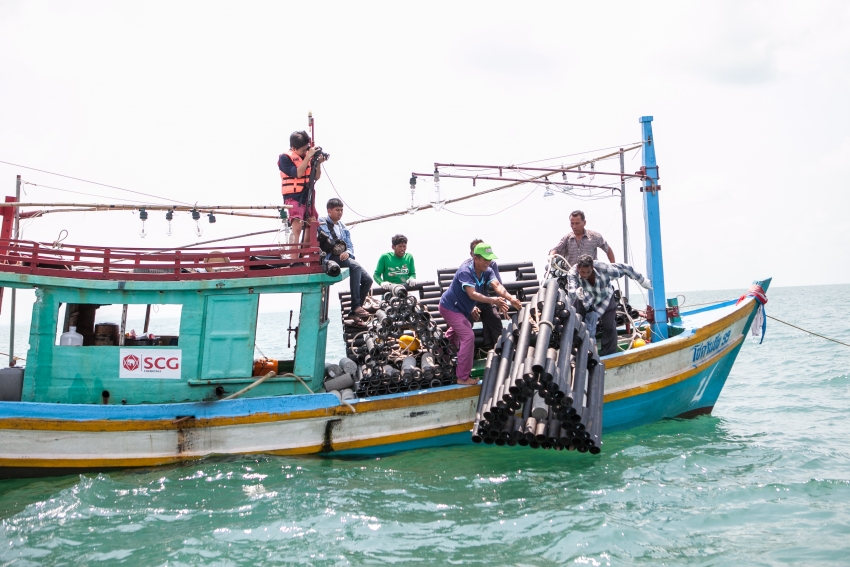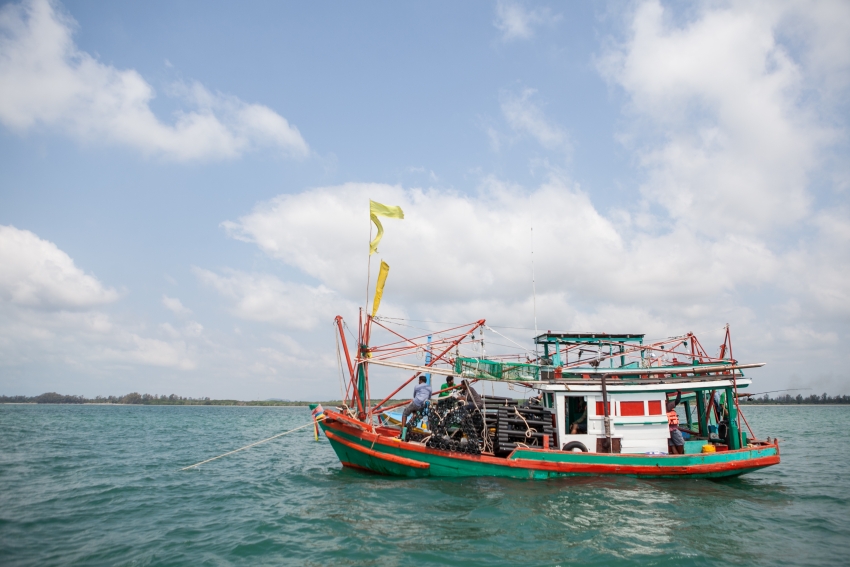Neun Kho Community, Rayong Province
The atmosphere in my hometown of Baan Neun Kho today is one of festivity and excitement. That’s because we’re celebrating the “Towards the 5th year of fish home for sustainable community” event, and Uncle Sam-oi, leader of the local fishermen’s group was on stage for a discussion.
It’s hard to believe that this is the fifth year of the project; time has flown by really quickly. I still remember 4 years ago when I was 16, Uncle Sam-oi called together the community elders to find ways to revive the coastal environment. At the time, the volume of fish caught by the local fishermen had dwindled drastically, and fishermen had to take the boats out farther and farther in order to catch fish and crabs.
One of the projects we piloted in our community is fish home construction for small marine creatures. The homes are created from many different materials found in the community, such as old rope or car tyres. After hearing about the project, SCG Chemicals approached us, inviting us to try using PE100 pipes. Black pipes were assembled in the shape of a house roof — a design quite different from that of the fish homes we been building. The design process was undertaken jointly by the SCG Chemicals staff and local fishermen, and we finally came up with a design we were happy with. Every time a fish home-building activity took place, the people in the community and the staff of SCG Chemicals would take part and transport the finished fish homes on fishing boats to be placed in designated areas. Although I had gone fishing with my mom and dad many times, I was still really excited on my first trip to place fish homes in the sea. To me, going on this trip and waiting to see what would happen next was more thrilling than catching fish.
Apart from fish home building, Uncle Sam-oi also rallied the people in our community to help take care of the coastal areas by collecting trash, planting mangrove trees, etc. The elders in the community also said that the community had to help take care of the fish homes that we placed in the sea—making the fish feel safe there so that they would become places fish come to spawn, and where baby fish could grow. We all agreed to not fish in the areas where the fish homes had been placed, and would make certain no one fished in the area so they would become fertile breeding grounds and nurseries for the marine life our community relied on.
Just four years after humble beginning of this project, the fish homes we’ve placed over the years can now be found all over the sea floor. When we go diving there we see that a large number of fish and other marine organisms have established their homes in these areas. More importantly, our local fishermen are now able to catch more fish without having to take their boats out very far. Our lives have improved. This helps members of the new generation in our community, like me, realize that caring for the sea is important for fishermen like us. The sea is not just the home of fish; it is our home too. And cooperation from a lot of people has helped achieve the realization of this project. Today, government agencies, the community and SCG Chemicals have come together in this “Towards the 5th year of fish home for sustainable community project”. I am glad that others realize the effort of our community has made in trying to revive the ecosystem and I am thankful for their support over the years.
On top of helping us with fish homes, the staff at SCG Chemicals also suggested that we set up “Neun Kho Fishery Learning Center” to pass onto other communities some of our local wisdom about fishery industry, and the story of what we have experienced and learned while conducting this project. Inside the exhibition center, there will be posters and information boards telling visitors of the way of life of the local fishermen and the success of the fish home project. It won’t be long before fishermen from other areas, as well as sea lovers and other interested people, come here for a visit to learn about the project. The elders also came up with an idea for an eco-fishing boat excursion. It sounds like a lot of fun and I, for one, plan to volunteer as a tour guide for Neun Kho.
I was deeply touched by what Uncle Sam-oi said on-stage today: “If we all put our heads together and help each other find solutions to problems, and respect the agreement, we can solve the problems sustainably.” Listening to his speech I was reminded of the monthly meeting the elders have. Uncle Sam-oi often says that, in order for the community to be truly strong and sustainable, it has to be self-reliant. The community needs to be the one initiating worthwhile projects before seeking support from the public or private sectors. SCG Chemicals has provided support to many community-initiated projects and I believe that this kind of support helps the people learn to rely on themselves and feel proud of themselves.
The event went smoothly and everyone is smiling with happiness. I too am sporting a big smile and I told myself that I will maintain the legacy of the local fisheries wisdom and pass it on to future generations so that our fertile source of income and pristine marine ecosystem will be with us till the end of time.
Materials and installation of fish homes
SCG Chemicals’ fish homes are made from polyethylene (EL-LeneTM H1000PC) or PE pipes that have passed the plastic pellet testing process by SCG Chemicals and the pipe property tests by VTT, Finland and other SFS-EN ISO 8795:2001 institutes worldwide. The chemicals in the pipe are extracted and the liquid tested for toxic chemicals, smell and contaminants by the experts and found to be free of toxic chemicals and therefore friendly to the environment. As PE is resistant to corrosion and can withstand high pressure, it is also long-lasting.
To assemble the fish home, 110 mm PE100 pipes are welded into a 2 m2 fish home (1.2 m wide, 1.2 m long and 1.1 m tall). Each home weighs about 250 kg. Then at least 10 homes are placed near one another. (Each cluster of homes covers an area of approximately 20 m2). The fish homes are then weighted using 200 kg of concrete ballast at the base. The fish homes are placed within the local fishery (small fishing boat fishery) radius so that it will be convenient for the local fishermen to watch over them.
Benefits of fish homes:
- Creates biodiversity in terms of both variety of species and number of marine creatures that have made the fish homes their habitats. Over 10 species of marine animals have taken up residence in the fish homes, including commercial fish such as yellow-stripe trevally, grouper, queenfish, sardine, spanner crab, ridge swimming crab, mussels, and ornamental fish such as batfish, stingray and diamond trevally.
- Increases coastal fisheries and marine habitat, nursery areas and shelter by over 1,600 m2 annually
- Creates a network of over 1,000 marine environment conservation areas annually
Towards the 5th year of the fish home project:
2012 Fish home project was initiated in December with 10 fish homes placed in Klaeng district, Rayong province.
2013 Placed 90 more fish homes in Rayong and announced the success of placing 100 fish homes at the “Pristine Beach, Fish Come Home: celebrating SCG’s 100th anniversary with 100 fish homes” event to commemorate SCG’s 100th anniversary.
2014 100 additional fish homes were places in Rayong and the project expanded to areas in Chonburi for the first time
2015 170 more fish homes were placed in Rayong and Chonburi provinces
2016 The project aims to place 400 more fish homes in Rayong and Chonburi provinces.








